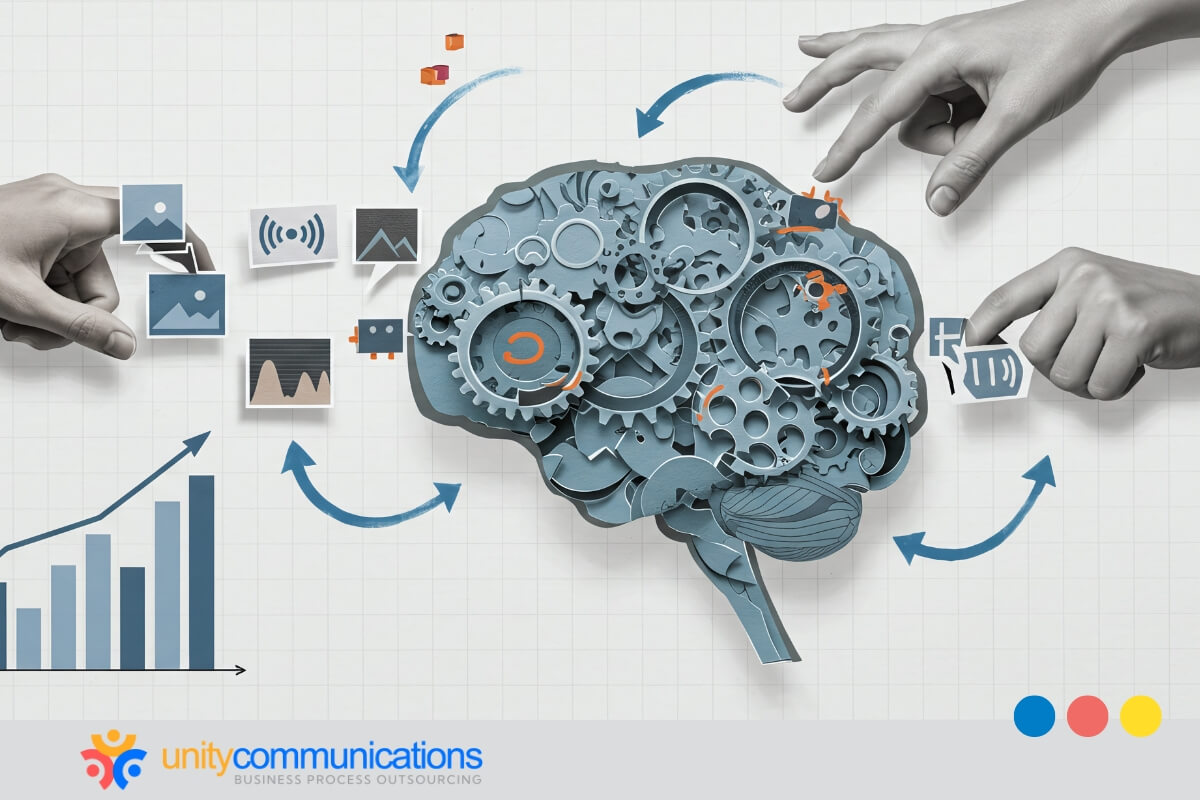Table of Contents
The right artificial intelligence (AI) agent can make a significant difference in terms of scalability, cost, and trust. Whether powering customer support, automating sales workflows, or enforcing compliance, they enhance efficiency, accuracy, and the bottom line.
However, choosing the wrong AI agent platform can lead to costly integration failures and wasted resources, whereas the right choice delivers competitive advantages that compound over time.
In this guide, we rank and review the top platforms based on performance, scalability, usability, integrations, cost, return on investment (ROI), and enterprise readiness. We provide “best for” picks and sourcing recommendations where it matters.
What is an AI agent platform?

An AI agent platform is software that helps you build, deploy, and manage autonomous agents or digital workers designed to handle tasks on your behalf. Think of it as a control center where you can create agents, provide them with instructions, and track their performance.
Unlike traditional automation tools that often require coding, most AI agent platforms today are low-code or no-code, meaning you can set up workflows with simple prompts or drag-and-drop interfaces. This makes them accessible to developers, business owners, freelancers, and teams wanting to save time and scale without adding headcount.
At their core, AI agent platforms turn repeatable processes into automated systems. If you can write down a step-by-step set of instructions that you’d usually give to an assistant or intern, chances are you can delegate that process to an AI agent.
- For individuals. Solopreneurs, freelancers, and small business owners can offload routine admin, research, or customer service tasks.
- For teams. Marketing, sales, and operations teams can utilize agents to manage campaigns, qualify leads, or handle reporting tasks.
- For enterprises. Large organizations can orchestrate multiple agents to work across departments, ensuring compliance, accuracy, and efficiency at scale.
The result is more output with fewer people. Just as virtual assistants freed up time in the past, AI agents take it a step further. They don’t need coffee breaks, sleep, or benefits.
Evaluation criteria: Key factors considered
Selecting an AI agent platform should be based on business priorities. Every organization faces unique pressures. Some need lightning-fast automation, others prioritize compliance, and many must prepare for rapid scaling. To avoid chasing hype, consider weighing six essential criteria that influence immediate results and long-term sustainability.
| Criteria | Why it matters | What to evaluate | Business implications |
| Performance | Accuracy and speed define reliability. Poor performance creates errors, customer frustration, and reputational damage. | Response time (latency), reasoning depth, error and hallucination rates, and benchmark results | High performance reduces operational risk, builds trust, and supports mission-critical processes. |
| Scalability | Growth demands systems that expand without failure. Platforms must be able to sustain performance under heavier loads. | Multi-agent orchestration, concurrent workloads, global availability, and cloud elasticity | Scalable platforms adapt to growth, preventing costly migrations and downtime. |
| Usability | Adoption accelerates when non-technical teams can contribute. Complexity slows implementation. | No-code or low-code tools, prebuilt templates, onboarding time, and learning curve | Usability empowers more teams, reducing IT bottlenecks and speeding ROI. |
| Integrations | Agents are only as helpful as the systems they connect with. Weak integrations limit impact. | Application programming interfaces (APIs), customer relationship management (CRMs), enterprise resource planning (ERP), data connectors, plug-ins, and ecosystem breadth | Strong integrations enable seamless workflows and ensure data accuracy. |
| Cost and ROI | Pricing varies widely and can hide additional costs. ROI is measured in both efficiency and risk avoidance. | Licensing model, infrastructure costs, support or training fees, total cost of ownership | Transparent pricing ensures sustainability and prevents stalled adoption. |
| Enterprise readiness | Without compliance and governance, platforms create legal and reputational risks. | Audit logs, data residency, access controls, and explainability features | Enterprise-ready platforms protect compliance, reduce risk, and inspire customer trust. |
Taken together, these six factors provide a lens through which companies can move past vendor hype and evaluate platforms on what matters most: business alignment, measurable ROI, and long-term resilience.
Best platforms your team should use
Below are the top AI agent platforms of 2025, ranked and reviewed against these criteria. Identify the solution that best fits your current operations and future growth needs.
1. CrewAI: Advanced orchestration for complex workflows
CrewAI positions itself as a leader in managing complexity. Unlike simpler platforms that rely on a single AI agent to perform multiple tasks, CrewAI specializes in multi-agent orchestration. Different AI agents can take on specific roles—one for data gathering, another for validation, and a third for execution—making workflows more precise and reliable.
Its strength is most evident in industries where compliance and accuracy are critical:
- In financial reporting, one AI agent can collect sensitive data, another can verify regulatory alignment, and a third can prepare final submissions.
- In supply chains, multiple AI agents coordinate across departments and geographies, ensuring smooth handoffs and reducing errors.
The trade-off is complexity. CrewAI requires skilled staff to design and manage orchestration frameworks, unlike no-code platforms, which can deploy a single AI agent. Onboarding takes more time, and costs rise as you add more agents and governance layers.
The investment pays off for enterprises with large-scale, multi-departmental processes. CrewAI is less about quick wins and more about long-term efficiency. It is best suited for large organizations where AI agent orchestration and compliance are essential to daily operations.
Pricing and details: Enterprise-tier pricing typically ranges from $2,000 to $5,000 per month, depending on the number of agents and governance features. Additional costs come from consulting support to design orchestration frameworks. CrewAI offers robust service-level agreements (SLAs) and enterprise support. However, onboarding can take weeks rather than days.
2. Lindy: No-code automation for business teams
Lindy makes AI agents accessible by allowing non-technical staff to build and manage automations. Its no-code interface and ready-made templates let sales, support, and HR teams deploy agents in days. Everyday use cases include lead routing, ticket triage, scheduling, and follow-ups, all with minimal IT involvement.
This approach reflects a broader market shift toward accessible automation. The global no-code AI platform market size was estimated at USD 3.83 billion in 2023 and is projected to reach USD 24.42 billion by 2030, highlighting the rapid adoption of tools that simplify AI deployment. For mid-sized companies without large IT infrastructures, Lindy offers a fast and affordable path to operational efficiency.
However, Lindy’s simplicity has limits:
- It works best at the departmental level and might struggle in compliance-heavy or highly complex workflows.
- Scaling often requires technical oversight.
As an AI agent platform, Lindy is a strong fit for quick wins. It empowers your teams without overwhelming IT. But it is not designed for enterprise-wide orchestration. Lindy is ideal for mid-sized firms or departments within larger organizations that seek immediate productivity boosts through user-friendly AI agent automation.
Pricing and details: SaaS subscriptions begin at around $30 to $50 per user per month, with free trials available. Paid plans unlock more templates and workflow runs. ROI is fast because deployment typically takes hours. However, scaling beyond departmental use might require higher-tier pricing and IT involvement.
3. IBM watsonx: Enterprise confidence through compliance
IBM watsonx is for governance and compliance, making it a top choice for industries including finance, government, and healthcare. Features such as audit trails, explainability, and enterprise-grade access controls foster accountability where regulations leave no room for error.
This platform shapes how regulated industries approach AI agent development. Governance tools are built into the process, ensuring agents are functional and compliant. This helps organizations innovate without compromising compliance.
These strengths come at a cost:
- Licensing, training, and deployment require significant investment.
- Customization can take longer than with leaner AI agent platforms.
However, the expense is justified as part of risk management for organizations facing strict oversight.
IBM watsonx is best for enterprises that value reliability and compliance above speed or flexibility. It provides the safeguards necessary for regulated sectors while supporting the development of compliant AI agents at scale.
Pricing and details: Licensing follows IBM’s enterprise software model, with custom quotes depending on industry and deployment scale. Expect six-figure annual contracts for large-scale rollouts, along with training and professional services fees. The expense is justified in highly regulated sectors where compliance failures are costlier.
4. AutoGPT: Open-source flexibility
AutoGPT represents the open-source wave in AI agents, offering transparency and adaptability that attract developers and startups eager to experiment. Its community-driven ecosystem drives rapid innovation, with contributors frequently releasing new tools and extensions. Teams can test ideas quickly at a minimal licensing cost, making AutoGPT a go-to for R&D and early-stage projects.
Open-source adoption is no longer a fringe movement. Research shows that 90% of enterprises use open-source software in some capacity, and 78% run their workloads on open-source technologies. AutoGPT benefits directly from this momentum, giving organizations the flexibility to build, deploy, and scale without being tied to a single vendor.
The challenge lies in reliability. Without strong oversight:
- AutoGPT agents can become stuck in infinite loops, produce hallucinated outputs, or exhibit unpredictable behavior.
- Operating costs for hosting, debugging, and monitoring often offset the savings from free licensing. This makes stability highly dependent on the skill of the implementing team.
For companies with strong in-house technical expertise, AutoGPT provides unmatched flexibility and innovation potential. It is best suited for organizations willing to invest in refining and supervising their agents, rather than those seeking a plug-and-play solution for large-scale enterprise use.
Pricing and details: Free to use under an open-source license, but hidden costs include hosting (GPU/CPU servers), monitoring, and engineering hours. On cloud infrastructure, running agents can cost between $300 and $1,500 per month per workload, depending on the workload’s intensity. Success depends on in-house expertise.
5. Claude Opus and Sonnet 4: Depth in reasoning and analysis
Claude’s Opus and Sonnet 4 models are AI agent platforms designed for reasoning-intensive tasks. They shine in compliance reviews, financial modeling, legal analysis, and market intelligence, where accuracy and context management are essential. Their ability to handle long inputs and return structured insights makes them a trusted choice for consulting and financial firms.
These platforms also highlight the importance of strong AI agent development tools. Combining advanced reasoning with structured outputs enables teams to build agents that respond and provide defensible, data-backed decisions. This makes them valuable in industries where trust and precision cannot be compromised.
The trade-off is cost and performance under pressure. Claude’s models are at the premium end of the market and might slow down during heavy workloads. However, the investment delivers meaningful returns for enterprises prioritizing insight and reliability over price.
Overall, Claude Opus and Sonnet 4 are best for:
- Organizations needing rigorous reasoning and decision support.
- Finance, law, and consulting firms that require agents built on robust AI agent development tools to minimize risk and maximize decision quality
Pricing and details: Claude Opus costs about $15 to $25 per million tokens, while Sonnet 4 offers lower pricing tiers. Enterprise packages provide volume discounts. Compared to open-source options, these sit at the premium end but deliver high reliability and longer context windows.
6. Salesforce Agentforce: CRM-native advantage
Salesforce Agentforce brings AI directly into the Salesforce ecosystem, embedding intelligence into sales and service workflows. AI agents gain instant access to customer data, cases, and pipelines, allowing teams to deliver personalized engagement and resolve issues faster. For companies already built on Salesforce, Agentforce feels like a natural extension rather than a separate tool.
Its strength is tied to Salesforce’s leadership in the CRM market. In 2023, Salesforce’s market share reached 21.7%, and the company gained more revenue than any other CRM vendor. This dominance ensures Agentforce has a vast customer base ready to integrate AI into existing workflows.
The limitation is flexibility. For non-Salesforce users:
- The integration costs are high, and the benefits are limited.
- Vendor lock-in is also a consideration, as Agentforce is designed primarily to enhance Salesforce-native environments rather than cross-platform systems.
For organizations already committed to Salesforce, Agentforce offers a low-friction approach to adopting AI in customer-facing roles. It strengthens sales and service operations without requiring a complete overhaul of existing systems, making it a strategic choice for scaling customer engagement.
Pricing and details: Bundled with Salesforce enterprise licenses, AI features usually add $75 to $200 per user per month on top of CRM plans. Costs are modest for existing Salesforce users, but high for those outside the ecosystem. Vendor lock-in is the main limitation.
7. Relevance AI: Compliance-driven orchestration
Relevance AI positions itself as an AI agent platform built with compliance and governance at its core. It emphasizes auditability, policy enforcement, and transparency, making it a strong option for industries where regulatory oversight is strict and unavoidable. Features such as detailed logs and behavior monitoring assure audits and internal reviews.
This focus makes Relevance AI especially attractive to sectors such as healthcare, legal, and finance. In these industries:
- Demonstrating control over every AI agent decision is just as important as the results themselves.
- By embedding governance into orchestration, the platform enables businesses to adopt AI confidently without compromising accountability.
The trade-off is ecosystem breadth. Relevance AI lacks the extensive integrations of larger players such as Microsoft or Salesforce. Costs can also rise due to regulatory requirements and compliance-related overhead. Still, for organizations where compliance is non-negotiable, the investment provides valuable protection against legal and reputational risk.
Relevance AI provides a practical solution for enterprises that must balance innovation with stringent regulations. It might not offer the scale of tech giants, but as an AI agent platform designed for compliance-first orchestration, it fills a vital gap for organizations that cannot afford mistakes in governance.
Pricing and details: Plans start at around $500 per month for small teams, with enterprise compliance packages ranging from $3,000 to $10,000 per month. Strong customer support is included for regulated sectors, but integrations are narrower compared to those of tech giants.
8. Azure Vertex AI Agent Builder: Cloud-native scale
Microsoft’s Azure Vertex AI Agent Builder is an AI agent platform that integrates tightly with Azure services, making it a strong fit for companies already built on Microsoft infrastructure. It supports global deployment at cloud scale with enterprise-grade security, monitoring, and built-in versioning, giving enterprises confidence in managing AI at scale.
One of its biggest strengths is flexibility in handling diverse workloads. From data-heavy analytics to customer-facing automation, the platform allows organizations to design and deploy agents across regions with minimal friction. This also makes it attractive to firms that rely on business process outsourcing (BPO). Providers can deploy agents globally to streamline operations and maintain consistency across geographies.
The trade-off is complexity and cost:
- Setting up requires technical expertise.
- Poorly managed resources can lead to rising cloud expenses.
Enterprises must carefully plan governance and usage policies to ensure returns, particularly when workloads expand rapidly.
For global enterprises committed to Microsoft’s ecosystem, Azure Vertex AI Agent Builder provides a natural path to scalable AI adoption. It is best suited for organizations that prioritize reach, reliability, and integration, while seeking to extend automation to both outsourced and internal operations.
Pricing and details: Pay-as-you-go cloud billing. Small pilots can cost $200 to $500 per month, while enterprise deployments scale into tens of thousands per month, depending on usage. Spot instances and reserved capacity can cut costs. It is best for companies that are already standardized on Azure.
9. SquadStack: Voice-first specialization
SquadStack is an AI agent platform designed for voice-first engagement, integrating AI automation with human-in-the-loop oversight. With this approach, you can handle calls quickly while maintaining the accuracy and empathy customers expect. Its focus makes it especially valuable for industries such as telecom, insurance, and large-scale call centers, where phone communication is dominant.
The importance of voice remains clear. A PwC survey found that 82% of U.S. consumers want more human interaction in customer service. By blending automation with human support, SquadStack addresses this demand more effectively than text-only solutions.
For sectors where calls are still the backbone of customer interaction, SquadStack delivers clear value. It helps call-heavy businesses boost efficiency without compromising quality, making it an excellent choice for enterprises that see reliable, AI-powered voice engagement as a competitive differentiator.
Pricing and details: Typically priced on a per-minute or per-call basis. Small deployments can start at around $1,000 per month, scaling up to $50,000 for enterprise call centers. It offers both AI-only automation and hybrid human+AI packages.
Comparison at-a-glance

Choosing the right AI agent platform can be overwhelming, given the numerous vendors promising cutting-edge capabilities. To simplify the decision, the table below distills each platform’s best fit, strengths, limitations, and use cases into a single view. You can quickly compare the options side by side before diving deeper into the detailed reviews.
| Platform | Best For | Strengths | Limitations | Use Cases |
| CrewAI | Large enterprises with multi-department workflows | Multi-agent orchestration, high accuracy in compliance-heavy tasks | Requires skilled staff, higher onboarding and scaling costs | Financial reporting, supply chain management, and regulatory workflows |
| Lindy | Mid-sized firms and departmental automation | No-code interface, fast deployment, low IT reliance | Not suited for complex or compliance-heavy workflows | Lead management, ticket triage, scheduling, HR automation |
| IBM watsonx | Regulated industries (finance, healthcare, government) | Governance, audit trails, explainability, enterprise access controls | High cost, slower customization | Compliance-driven workflows, regulated AI agent development |
| AutoGPT | Developers, startups, R&D teams | Open-source, rapid innovation, low licensing costs | Reliability depends on team skills, hidden infra costs | Experimentation, prototyping, and AI customization |
| Claude Opus and Sonnet 4 | Finance, legal, and consulting industries | Deep reasoning, long-context management, structured outputs | Premium pricing, slower under heavy load | Compliance reviews, financial modeling, legal analysis |
| Salesforce Agentforce | Salesforce-native organizations | Deep CRM integration, real-time customer data access | Limited outside Salesforce, high integration costs | Customer engagement, sales productivity, and case management |
| Relevance AI | Healthcare, legal, finance | Compliance-first orchestration, strong audit features | Smaller ecosystem, higher regulatory overhead | Regulated workflows, governance-heavy AI adoption |
| Azure Vertex AI Agent Builder | Global enterprises on Azure | Cloud-native scale, enterprise security, strong integration | High cost if unmanaged, technical expertise needed | Global deployments, BPO support, multi-region AI |
| SquadStack | Telecom, insurance, call-center-heavy firms | Voice-first design, human-in-loop oversight | Higher infrastructure costs, limited outside voice-heavy industries | Customer service calls, insurance claims, telecom support |
Best practices
Once you’ve chosen the right AI agent platform and begin development, it’s important to follow practices that set you up for long-term success. Early wins are valuable, but the real competitive advantage comes from building sustainable systems that can adapt and scale.
Below are proven best practices that leading organizations use to maximize the value of their AI agents:
1. Build agent systems, not isolated tools
The temptation when starting is to create one AI agent for each task, but this often results in silos that don’t communicate well. A better approach is to design interconnected agent systems. For example, one agent can collect raw data, another can analyze patterns, and a third can act on the insights. This mirrors how effective human teams work. Each person has a role, but together, they deliver outcomes greater than the sum of their parts.
Companies such as OpenAI and Anthropic emphasize this orchestration model because it improves accuracy and accountability. With specialized agents sharing responsibilities, you can catch errors earlier, and performance improves over time. Building systems instead of standalone bots ensures that your AI completes tasks and contributes to a larger, more intelligent workflow.
2. Follow the proven four-step workflow
A structured workflow keeps AI agents aligned with business goals. The widely recommended four-step approach includes:
- Assigning tasks
- Planning and delegating work
- Iterating outputs
- Executing actions
Each stage builds on the previous one to create accurate and actionable outputs.
Feedback loops are essential here. Agents should be able to refine their results before final delivery, much like an employee reviewing a draft before sending it to a manager. This cycle of planning, improvement, and execution reduces errors and builds trust in the system. Over time, teams can expand the workflow with custom steps, but starting with this foundation creates consistency and reliability.
3. Avoid common implementation mistakes
One of the biggest misconceptions is treating AI agents like traditional automation bots. Unlike simple “if-this-then-that” workflows, agents thrive in ambiguous or dynamic situations where rule-based logic would break down. Trying to use them for basic repetitive tasks not only wastes potential but can also create unnecessary complexity.
Instead of attempting to automate everything at once, focus first on high-value processes where intelligent decision-making adds real impact, such as customer support triage, fraud detection, or market analysis. By targeting these use cases, you can see early returns without overwhelming teams. From there, you can scale to other areas with more confidence and experience.
4. Measure what matters
Adoption without measurement is risky. To prove ROI, you must track quantitative metrics (e.g., resolution times, error reduction, throughput) and qualitative indicators (e.g., user satisfaction, employee adoption). Having clear baselines allows you to measure whether AI agents are truly delivering improvements.
Regular review cycles ensure you can actively monitor and optimize performance. Based on feedback, you can identify underperforming workflows, retrain models, or adjust integrations. This measurement culture transforms AI agents into evolving assets, rather than static tools, ensuring they continue to create value as business needs evolve.
5. Plan for growth from day one
AI agent deployments often start small but can expand rapidly once teams see results. Without planning, costs for APIs, infrastructure, and support can scale unpredictably. Treat scalability as a design principle from the start. Estimate future usage, prepare cloud resources, and implement governance to manage expenses.
Beyond infrastructure, growth requires people. Investing in internal training reduces dependence on external vendors and helps staff troubleshoot, adapt, and innovate with AI agents.
Many organizations discover that successful agent adoption sparks larger digital transformation projects, including rethinking workflows, redesigning customer experiences, and re-evaluating business models. By planning for growth, you ensure your AI strategy matures alongside your business rather than holding it back.
AI agents: Passing hype or shaping the future?

AI agents have attracted massive attention, and like any emerging technology, the question arises: Are they just another tech buzzword or the foundation of the next wave of digital transformation?
The truth lies somewhere in between. Early hype has certainly exaggerated some capabilities, leading to unrealistic expectations. Yet behind the noise, the adoption data tells a clear story: businesses are moving from experiments to real-world deployments.
Gartner projects that 15% of everyday work decisions will be made autonomously through agentic AI by 2028. While the percentage seems modest, it signals a significant shift in how organizations delegate decision-making. Even a small share of daily business choices handled by AI agents translates to faster operations, lower costs, and more scalable decision processes.
The key is treating AI agents not as magic bullets but strategic tools. They excel when:
- Aligned with business priorities
- Supported by the proper infrastructure
- Monitored for compliance
Companies that rush in without planning might experience failures that fuel skepticism, while those that adopt with clear frameworks will find AI agents becoming integral to long-term growth.
The takeaway for decision-makers is clear: AI agents are here to stay. However, their success depends on disciplined strategy, thoughtful platform selection, and a focus on business value. The organizations that prepare today will prove that AI agents are not just passing hype—they shape the future.
The bottom line
The AI agent platform market in 2025 is crowded, but differentiation is evident when viewed through the lens of business needs. No single tool dominates every scenario. Instead, the best choice depends on whether a company values compliance, speed, scalability, reasoning, or customer engagement most.
Executives must consider their organizations’ trajectory. A platform that prioritizes compliance might seem costly now, but it will prevent regulatory penalties later. A no-code solution might look lightweight, but it can accelerate adoption across non-technical teams.
The winning strategy is to select an AI agent platform that balances immediate needs with long-term ambitions, ensuring that its adoption supports growth and resilience.
If you’d like help designing an agent stack that balances governance, cost, and speed, let’s connect.




